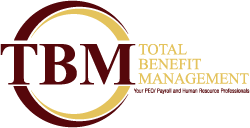- Total Benefit Management

How to Write An Unforgettable Company Mission Statement
September 17, 2019
5 Simple Questions That Can Free Up Hours In Your Day
September 24, 2019This article comes from Entrepreneur.
4 Reasons Informed Employees Are Happy Employees
Employee training improves productivity and offers a host of additional benefits that will directly impact your company’s bottom line. Because of this, it should never be treated as an afterthought. Rather, it should be a top priority for you and your human resources department. That’s why we recommend the following four bits of insight and guidance.
1. Quality training creates a high-engagement culture.
Employee engagement is a hot topic in today’s work world. Employees who are highly engaged are more productive and less likely to quit their jobs. Even more importantly, they help build a positive culture around your brand, resulting in a more team-focused environment. In many cases, a highly engaged employee can even serve as your best recruiter when looking for new talent.
Unfortunately, the modern workplace as a whole is highly disengaged. Gallup research from 2018 reported that 34 percent of U.S. employees are “engaged” at work. While this ties a record-high engagement level, it means the majority of workers are disengaged, not putting in their best effort and ready to leave their employer as soon as a better offer comes along.
2. Use training to improve productivity, individually and as a whole.
Training is most important during the onboarding process when a new hire is still learning the ropes of their job. Harvard Business Review notes that, depending on the position, it can often take high-level hires between six months to a year to fully acclimate to their new role. The good news is that training can drastically cut the amount of time it takes for a new hire to “get up to speed” at any level in the company. Even seemingly mundane tasks, like covering your business’s unique jargon or explaining processes for using an in-house software program, will help eliminate the early roadblocks that slow down a new hire’s productivity.
Ongoing training can provide similar benefits, helping employees become more productive and efficient in their assigned roles. Case studies have consistently found that even a small investment in training can lead to big improvements later on. For example, as Stephen Maclaren reported for Entrepreneur, Motorola saw a 30 percent productivity increase for each dollar invested in employee training.
3. Keep up with changing tech and industry trends.
The fact that technology has had (and is continuing to have) a massive effect on the business world is no secret. Despite this, a PwC survey found that 47 percent of employees feel that their company doesn’t address their needs when introducing new technology. At the same time, the vast majority of employees across a wide range of industries “report that they’re willing to spend up to two days per month on training to upgrade their digital skills if offered by their employer.”
Any time you introduce a new software program or adapt your processes to adjust to industry changes, you must consider how this will affect the day to day activities of your workers. New software may promise improved productivity, but you will only get these results if your team knows how to use it. By providing your team with the resources they need to keep up (or even get ahead) in an ever-changing world, they will respond more positively to internal changes and be better equipped to deliver the results your company needs.
Click here to continue reading this article.

